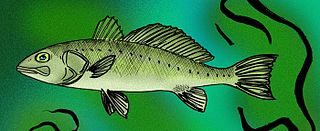
The Lamniformes are an order of sharks commonly known as mackerel sharks. It includes some of the most familiar species of sharks, such as the great white as well as less familiar ones, such as the goblin shark and megamouth shark.

Carcharodon is a genus of sharks within the family Lamnidae, colloquially called the "white sharks." The only extant member is the great white shark. Extinct species include C. hubbelli and C. hastalis. The first appearance of the genus may have been as early as the Early Miocene or Late Oligocene. Carcharocles megalodon is still argued by some paleontologists to be a close relative of Carcharodon carcharias - as well as being in the same genus. When Megalodon belonged to this genus it had the scientific name Carcharodon megalodon. More recently, Megalodon has been assigned by most scientists to either the genus Carcharocles or Otodus.

Opahs, also commonly known as moonfish, sunfish, cowfish , kingfish, and redfin ocean pan are large, colorful, deep-bodied pelagic lampriform fishes comprising the small family Lampridae.

The Gempylidae are a family of scombriform ray-finned fishes commonly known as snake mackerels or escolars. The family includes about 25 species.

Sarda chiliensis, the eastern Pacific bonito, is a marine species of bonito. It ranges from Ecuador to Chile. Sarda lineolata, which ranges from Alaska to Mexico was formerly considered a subspecies, as Sarda chiliensis lineolata, but this treatment renders the species geographically disjunct.

A piscivore is a carnivorous animal that primarily eats fish. The name piscivore is derived from Latin piscis 'fish' and vorō 'to devour'. Piscivore is equivalent to the Greek-derived word ichthyophage, both of which mean "fish eater". Fish were the diet of early tetrapod evolution ; insectivory came next; then in time, the more terrestrially adapted reptiles and synapsids evolved herbivory.

Euzaphlegidae is a family of extinct escolar-like ray-finned fish closely related to the snake mackerels. Fossils of euzaphlegids are found from Paleocene to Late Miocene-aged marine strata of Europe, the Caucasus Mountains, India, Iran, Turkmenistan, Italy, and Southern California.

Euzaphleges longurio is an extinct, superficially mackerel-like fish related to the escolar and snake mackerels. Euzaphleges was found off the coast of what is now California during the late Miocene. It was smaller than the very similar Thyrsocles and longer and more slender than Zaphlegulus, which also lived at the same time. It was much longer than the poorly known Trossulus.

Laytonia is an extinct genus of prehistoric halosaur that lived in deep water off the North American Pacific Coast from the Zemorrian Epoch until during the Upper Miocene subepoch, when tectonic uplift effectively destroyed the genus' habitat by making the deep water too shallow.
Eclipes is an extinct genus of prehistoric marine ray-finned fish that lived off the coast of western North America during the Late Miocene. It was a member of the Gadidae, making it closely related to modern cods and haddocks. The several species known from this genus inhabited deep waters in what is now the Los Angeles Basin of southern California.

Bolbocara is an extinct genus of rattail that lived during the Upper Miocene subepoch of Southern California. It contains a single species, B. gyrinus. It may be related to the extant genus Bathygadus.
Tunita is an extinct genus of prehistoric mackerel that lived during the Upper Miocene subepoch of Southern California.

Lompoquia retropes is an extinct genus of ray-finned fishes belonging to the family Sciaenidae, the drums. These fishes lived what is now Southern California during the Upper Miocene subepoch.
Ioscion morgani is an extinct prehistoric bony fish that lived during the Upper Miocene subepoch of what is now Southern California. It is primarily known from incomplete fossils, such as the holotype, which consists of a broken backbone. Although the head is unknown, enough of the animal's anatomy suggests a relationship with the jackfishes of Carangidae.

Chalcidichthys is an extinct genus of prehistoric manefish. It contains a single species, C. malacapterygius, that lived during the Upper Miocene of Southern California. It is known from the Modelo Formation in Los Angeles County, and specimens were found during construction of a tunnel on Sepulveda Boulevard. It is assumed to have preyed on siphonophores, like its living relatives.

Lampris zatima is the oldest known opah of the genus Lampris, from the Late Miocene of Southern California. Its fossil record is rather poor, known primarily from isolated vertebral columns, and a few headless specimens. Alive, it is estimated to have been around 20 to 30 centimeters long.
Araeosteus is an extinct genus of marine ray-finned fish, closely related to the modern-day prowfish. It contains a single species, A. rothi which is known from Late Miocene (Tortonian)-aged marine strata in Southern California, primarily the Diatom Beds of Lompoc and the Santa Monica Mountains.
Megachasma applegatei is an extinct species of megamouth shark from the Oligocene to early Miocene of the Western United States. The type fossil was discovered in the San Joaquin Valley in 1973, but only described in 2014, when the species was named after its discoverer, Shelton Applegate.

Carcharoides is an extinct genus of mackerel shark which lived during the Oligocene and Miocene epochs. It is a widespread genus, known from specimens in North and South America, Europe, Africa, and Australia. It is most common in the European portion of its range, being comparatively uncommon in other places. It is only known from isolated teeth, which are relatively delicate.
Ozymandias gilberti is a species of extinct ray-finned fish from the Miocene which was described by David Starr Jordan in 1907 from a single specimen, comprising the skull and some vertebrae, discovered from San Pedro, California. It is thought to be a species of large mackerel or tuna in the family Scombridae. Jordan initially assigned another fossil to this species but changed his mind and assigned the second fossil to the living Cottoid genus Ophiodon, the lingcod, as Ophiodon ozymandias. The specific name honours the discoverer of the fossil Dr James Z. Gilbert.














